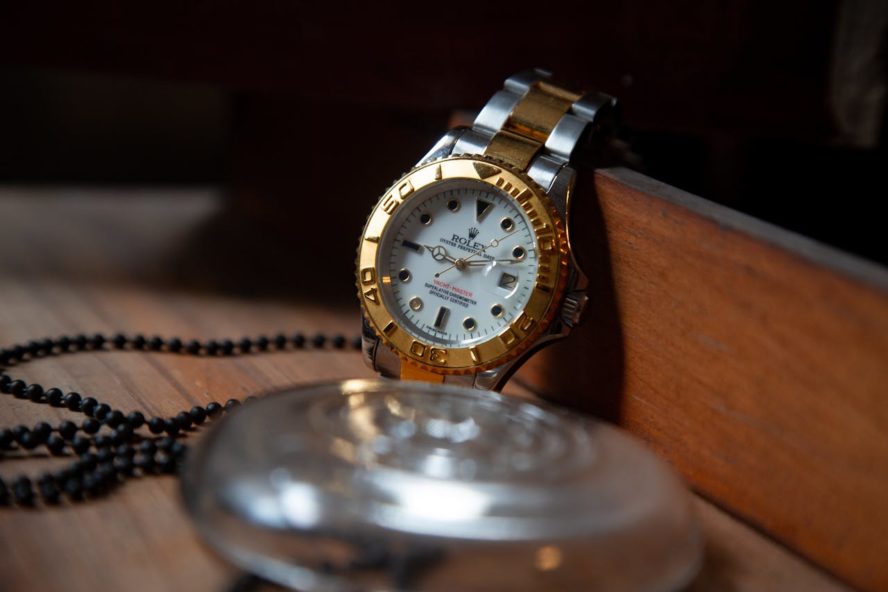Rolex, the ultimate symbol of luxury and precision in watchmaking, has a history as rich and intricate as its timepieces. Founded in 1905 by Hans Wilsdorf and Alfred Davis, Rolex has evolved from a budding watch company into a global icon synonymous with elegance, performance, and innovation.
The Early Years: A Vision Takes Shape
The story of Rolex begins in London, where Wilsdorf and Davis started a watch distribution business. Wilsdorf, a visionary with an eye for precision, saw an opportunity in wristwatches—a relatively new concept at the time. Pocket watches were the norm, but Wilsdorf believed wristwatches could be precise and stylish.
In 1908, Wilsdorf registered the trademark “Rolex,” a name chosen for its brevity and easy pronunciation in any language. The company relocated to Geneva, Switzerland, in 1919, placing Rolex at the heart of high-quality watchmaking. By this time, Rolex had made significant strides in wristwatch accuracy, earning a Swiss Certificate of Chronometric Precision in 1910.
Innovations that Defined an Era
Rolex’s history is punctuated by groundbreaking innovations that set the watch industry’s standard. In 1926, Rolex introduced the Oyster, the world’s first waterproof wristwatch. This invention marked a turning point in watch durability and reliability, sealing the watchcase against dust and water. The Oyster’s prowess was famously demonstrated in 1927 when Mercedes Gleitze swam across the English Channel wearing an Oyster, proving its waterproof capabilities.
The next major milestone came in 1931 with the invention of the Perpetual movement, the world’s first self-winding mechanism. This development eliminated the need for manual winding, a significant convenience that further cemented Rolex’s reputation for innovation.
During the mid-20th century, Rolex introduced several iconic models that have become legends in their own right. The Datejust, launched in 1945, was the first wristwatch with an automatically changing date on the dial. The Submariner unveiled in 1953, set the standard for diving watches with its unmatched waterproofness and rotating bezel. The GMT-Master, introduced in 1955, catered to the needs of international pilots by displaying multiple time zones.
Rolex and Exploration: A Commitment to Excellence
Rolex’s commitment to excellence extended beyond watchmaking to the world of exploration. The brand’s timepieces have accompanied explorers to the highest peaks and the deepest depths. In 1953, Sir Edmund Hillary and Tenzing Norgay conquered Mount Everest, each equipped with a Rolex Oyster Perpetual. This feat highlighted the reliability of Rolex watches in extreme conditions.
In 1960, the Bathyscaphe Trieste, piloted by Jacques Piccard and Don Walsh, descended to the Mariana Trench’s bottom, the ocean’s deepest point. Attached to the exterior of the submersible was a specially designed Rolex Deep Sea Special, which emerged unscathed, demonstrating unparalleled durability.
The Modern Era: An Iconic Status Solidified
As the decades progressed, Rolex continued innovating while maintaining its precision and luxury heritage. The 1970s saw the introduction of the Rolex Oysterquartz, a response to the quartz crisis that threatened traditional watchmaking. Despite the industry shift towards quartz movements, Rolex remained committed to mechanical watchmaking, blending tradition with modern technology.
In the 1980s and 1990s, Rolex expanded its influence through strategic partnerships and endorsements. The brand’s association with prestigious events such as Wimbledon, the 24 Hours of Le Mans, and the Oscars cemented its status as a symbol of success and achievement. Celebrities, athletes, and world leaders became ambassadors of the brand, further enhancing its iconic status.
Craftsmanship and Innovation: The Rolex Way
Its unwavering commitment to craftsmanship and innovation lies at the heart of Rolex’s success. Each Rolex watch is a masterpiece of engineering, meticulously crafted by skilled artisans in Geneva. The company maintains complete control over the production process, from forging its gold to assembling the intricate movements.
Rolex’s dedication to innovation is evident in its use of cutting-edge materials and technologies. The brand pioneered using 904L stainless steel, known for its superior corrosion resistance and aesthetic appeal. Rolex also developed Cerachrom bezels, a virtually scratch-proof ceramic material, and the Parachrom hairspring, enhancing its movements’ accuracy and durability.
Legacy and Future: Timeless Elegance
Rolex’s legacy is built on innovation, precision, and an uncompromising commitment to quality. The brand’s timeless designs have transcended trends, making Rolex watches coveted heirlooms passed down through generations. Each model tells a story of technical prowess and aesthetic perfection, embodying the values Hans Wilsdorf envisioned over a century ago.
Looking to the future, Rolex continues to push the boundaries of watchmaking while honouring its storied past. The brand’s ongoing pursuit of excellence ensures that Rolex will remain an icon of luxury and innovation for generations to come.
Final Thoughts
From its humble beginnings in early 20th-century London to its current status as a global symbol of luxury and precision, Rolex’s journey is a testament to the power of vision, innovation, and relentless pursuit of excellence. As the brand continues to evolve, it remains true to its heritage, crafting timepieces that are not only instruments of time but also symbols of success, adventure, and timeless elegance.
- The Future of Fashion Accessories: Durable and Sustainable Choices - August 29, 2024
- 8 Creative Ways to Personalize Your Engagement Ring - August 26, 2024
- Eco-Friendly Wedding Fashion: Sustainable Choices for the Conscious Bride - August 26, 2024
- How Stylish Sunglassеs Can Rеdеfinе Your Evеryday Look? - August 26, 2024
- Essential Beauty and Fashion Tips to Create Stunning Looks with Confidence - August 25, 2024

